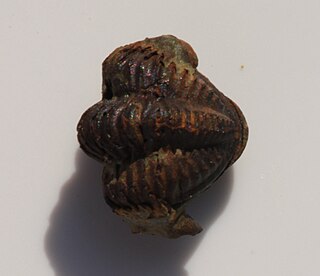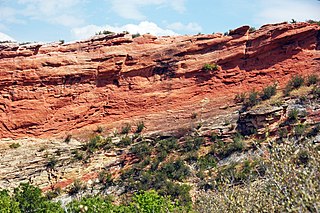Illiniichthys is an extinct genus of prehistoric bony fish that lived during the late Moscovian stage of the Pennsylvanian epoch in what is now Illinois, United States. Fossils were collected from the Mazon Creek fossil beds. The genus is named after the Illini Native American tribe.
Nozamichthys is an extinct genus of prehistoric bony fish that lived during the late Moscovian stage of the Pennsylvanian epoch in what is now Illinois, United States. Fossils were collected from the Mazon Creek fossil beds. The first part of the genus name is Mazon spelled backwards, and the second part means 'fish'.
Aaglacrinus is an extinct genus of crinoidea in the Cladia order. It has been proposed that it was a stationary (attached) suspension feeder the hard parts of which were composed of magnesium calcite.
Aglaocrinus is an extinct species of crinoids in the Cladia order. It has been proposed that it was a blind, stationary (attached) suspension feeder the hard parts of which were composed of magnesium calcite. It has been discovered in 3 locations in North America.
The Morrow Group was a geologic group in Arkansas that is now abandoned and replaced by the Bloyd Formation and the Hale Formation. It preserves fossils dating back to the Pennsylvanian period.
The Dewey Formation is a geologic formation in Iowa and Oklahoma. It preserves fossils dating back to the Carboniferous period.

The Wann Formation is a geologic formation in Kansas and Oklahoma. It preserves fossils dating back to the Carboniferous period.
The Hogshooter Formation is a geologic formation in Oklahoma. It preserves fossils dating back to the Carboniferous period.
The Johns Valley Formation is a geologic formation in Arkansas and Oklahoma. It preserves fossils dating back to the Carboniferous period.
The Boggy Formation is a geologic formation in Arkansas and Oklahoma. It preserves fossils dating back to the Carboniferous period.
The Ada Formation is a geologic formation in Oklahoma, within and to west of Ada. It consist mainly of shale with numerous limestone layers which get thinner and eventually disappear to the south, where they are replaced by fine-grained sandstone. Fossils are rare. Disarticulated remains of Eryops, Diasparactus, and Ophiacodon from the Ada Formation represent the first finds of these genera in Oklahoma.
The Gunsight Limestone Member is a geologic member in Texas. It preserves fossils.

The Casper Formation is a geologic formation in Wyoming, USA. It preserves fossils dating back to the Pennsylvanian period.
The Weber Formation is a geologic formation in Colorado. It preserves fossils dating back to the Late Pennsylvanian.
The Watson Ranch Quartzite is a geologic formation in Utah. It preserves fossils dating back to the Ordovician period.
The Martin Formation is a geologic formation in Arizona. It preserves fossils dating back to the Devonian period.
The Naco Group is a geologic group in Arizona. It preserves fossils dating back to the Permian period.
The Saginaw Formation is a geologic formation in Michigan. It preserves fossils dating back to the Pennsylvanian period.
The Grand River Formation is a geologic formation in Michigan. It preserves fossils dating back to the Pennsylvanian period.
The Horquilla Formation is a geologic formation exposed in southern Arizona and New Mexico. It preserves fossils dating back to the Pennsylvanian.




